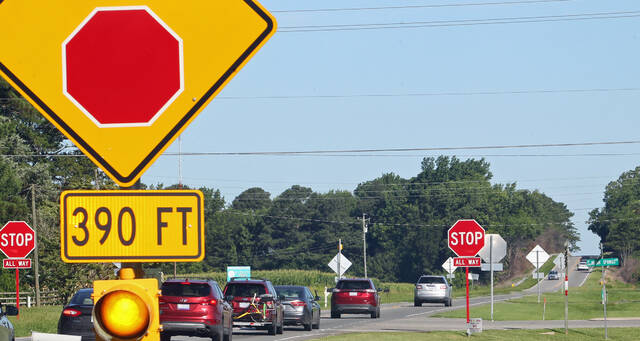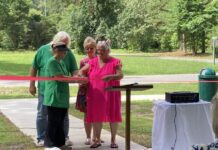
A sign and flashing light warn motorists traveling west on N.C. 55 toward Mount Olive that they are approaching the all-way stop at the road’s intersection with Secondary Road 1744 (Old Seven Springs Road and Indian Springs Road). The N.C. Department of Transportation plans to turn the intersection into a single-lane roundabout as part of an $8 million project that includes eliminating the intersection of N.C. 55 and North Church Street. Also, North Church Street will end with a cul-de-sac, and the Old Seven Springs Road/Indian Springs Road and North Church Street intersection will be converted to an all-way stop. (Steve Herring|mountolivetribune.com)
The intersection of N.C. 55 and Secondary Road 1744 (Indian Springs Road/Old Seven Springs Road) is scheduled to be converted into a single-lane roundabout as part of an $8 million project that includes eliminating the intersection of N.C. 55 and North Church Street.
The section of Secondary Road 1744 that runs parallel east and west to North Church Street is known as Old Seven Springs Road. It is known as Indian Springs Road after crossing North Church Street from where it continues east, crossing N.C. 55 before ending at N.C. 55 near Seven Springs.
As part of of the project, North Church Street will end at a cul-de-sac, and the intersection of Indian Springs Road/Old Seven Springs Road and North Church Street will be converted to an all-way stop.
Right-of-way acquisition is scheduled for November 2025
“It is currently scheduled to be advertised and a bid awarded in October 2026,” said Andrew Barksdale, N.C. Department of Transportation spokesman. “That means the contractor would proceed sometime in late 2026, only doing preliminary work, such as grading and relocating any water or sewer lines, etc.
“I wouldn’t expect major construction or traffic closures until sometime in 2027. Until the design and bidding documents are finalized, we won’t know the construction schedule or completion times yet. We plan to have a public meeting in fall 2025 There will be some temporary traffic closures at this location during construction.”
The project will primarily be funded as a federal Carbon Reduction Program grant.
It will be a roundabout, not a traffic circle, Barksdale added.
“We don’t use the term traffic circle because those are typically larger than a roundabout, and we don’t really build traffic circles any more,” he said.
•
The following information is from the N.C. Department of Transportation website:
Roundabouts improve safety for drivers, pedestrians and bicyclists. They also help reduce the congestion and backups more typical of traditional intersections with stop signs and traffic signals.
Drivers generally enters the roundabout more quickly than if waiting at a traffic signal. In addition, the modern roundabout is much smaller than older traffic circles and requires vehicles to travel at lower speeds (15-20 mph), making them safer than traffic circles.
Additionally, the slower speeds make it easier for a driver to find a gap of traffic inside the roundabout before safely entering it.
A roundabout is easy to drive through once you understand how it works. As you approach it, you’ll see a yellow “roundabout ahead” sign, indicating you should slow down.
Drivers yield to any vehicles or bicyclists already in the roundabout. Everyone using the roundabout moves in a counterclockwise direction, and those already in it do not yield to approaching vehicles.
Drivers should use turn signals when exiting and yield to pedestrians using a crosswalk at the roundabout.
The NCDOT website explains how to navigate a single-lane roundabout:
Once inside the roundabout, you simply exit at the desired street: travel a quarter of the way around to turn right at the next street; go halfway around to continue straight; instead of making a traditional left turn, go three-quarters around before exiting to the right; travel full circle to make a U-turn
The NCDOT offers the following tips for roundabout traffic:
Remember to give larger trucks and buses extra room, as they might need to straddle the lane.
Big trucks should use the concrete island — called the truck apron — to help drivers maneuver around the roundabout.
Never enter a roundabout while an emergency vehicle using flashing lights and sirens is passing through. If drivers are already in the roundabout, exit first, then pull over to let the emergency vehicle pass.
Bicyclists should pick the appropriate lane before entering a multi-lane roundabout and stay in the middle of their chosen lane. Do not ride along the shoulder of the roundabout.
Drivers should not pass a bicyclist while inside the roundabout.
Pedestrians should use marked crosswalks along the outside of the roundabout, and not walk through the middle of it.
According to the NCDOT Traffic Safety Unit (2020),the following safety improvements were achieved after roundabouts replaced 13 intersections with 55 mph speed limits:
— Total crashes: Down 41 percent
— Fatal and injury crashes: Down 79 percent
— Frontal-impact crashes: Down 62 percent
Similar results were found after 30 roundabouts were constructed across North Carolina:
— Total crashes: Down 46 percent
— Fatal and injury crashes: Down 76 percent
— Front-impact (head-on) crashes: Down 75 percent




